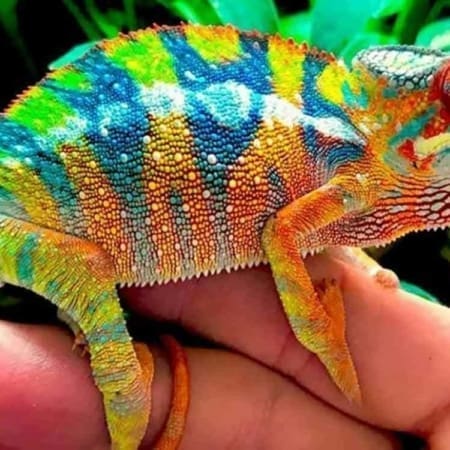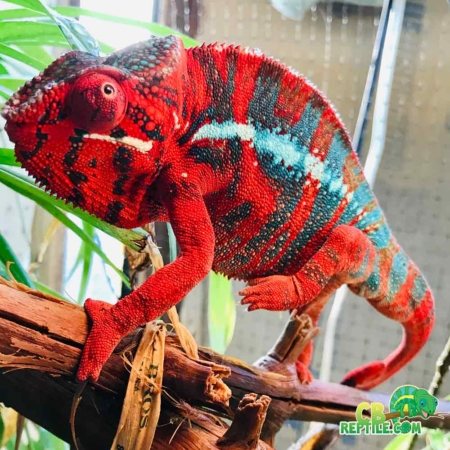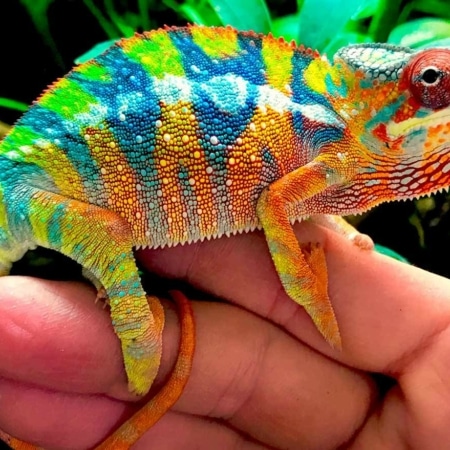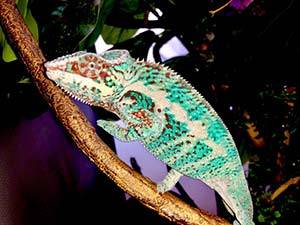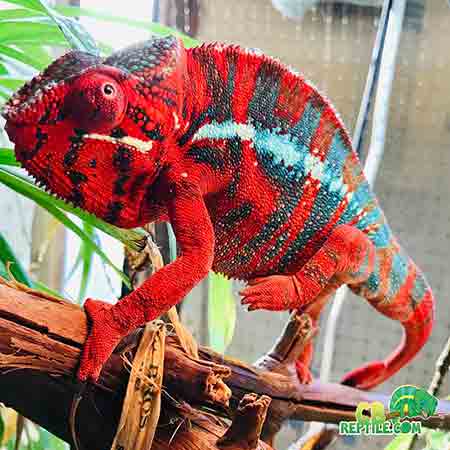Pairing & Compatibility for Panther Chameleons
Breeding panther chameleons requires far more than simply placing a male and female together. Successful pairing depends on compatibility, health, timing, behavioral cues, proper environmental preparation, and strict monitoring. Unlike many reptiles, panther chameleons are naturally solitary and highly territorial. Introductions must be planned carefully to avoid stress, injury, or failed breeding attempts. This guide provides an in-depth look at how to properly select, prepare, and pair panther chameleons to maximize success while ensuring the health and safety of both animals.
Starting with high-quality, robust bloodlines—preferably from the best chameleon breeder—is the foundation of any responsible breeding program. Healthy, captive-bred adults with predictable genetics and stable temperaments provide the best outcomes for pairing and successful reproductive cycles.

Choosing the Right Breeding Pair
The first and most important step in breeding is selecting two compatible chameleons with strong lineage traits, proper age, excellent health, and no genetic defects. Because panther chameleon locales have distinct coloration and genetic patterns, pairing must be intentional and planned.
Key qualities to look for in a breeding pair:
- Healthy body condition with no signs of MBD or past injuries
- Clear eyes and strong grip strength
- Consistent appetite and hydration habits
- Stable coloration appropriate to age and locale
- Known genetics from reputable breeders
- No history of reproductive complications in the female
Genetic integrity matters. Mixing locales is generally discouraged unless the goal is deliberately producing crosses, which must always be disclosed. Most breeders keep lineages pure so babies express expected coloration patterns.
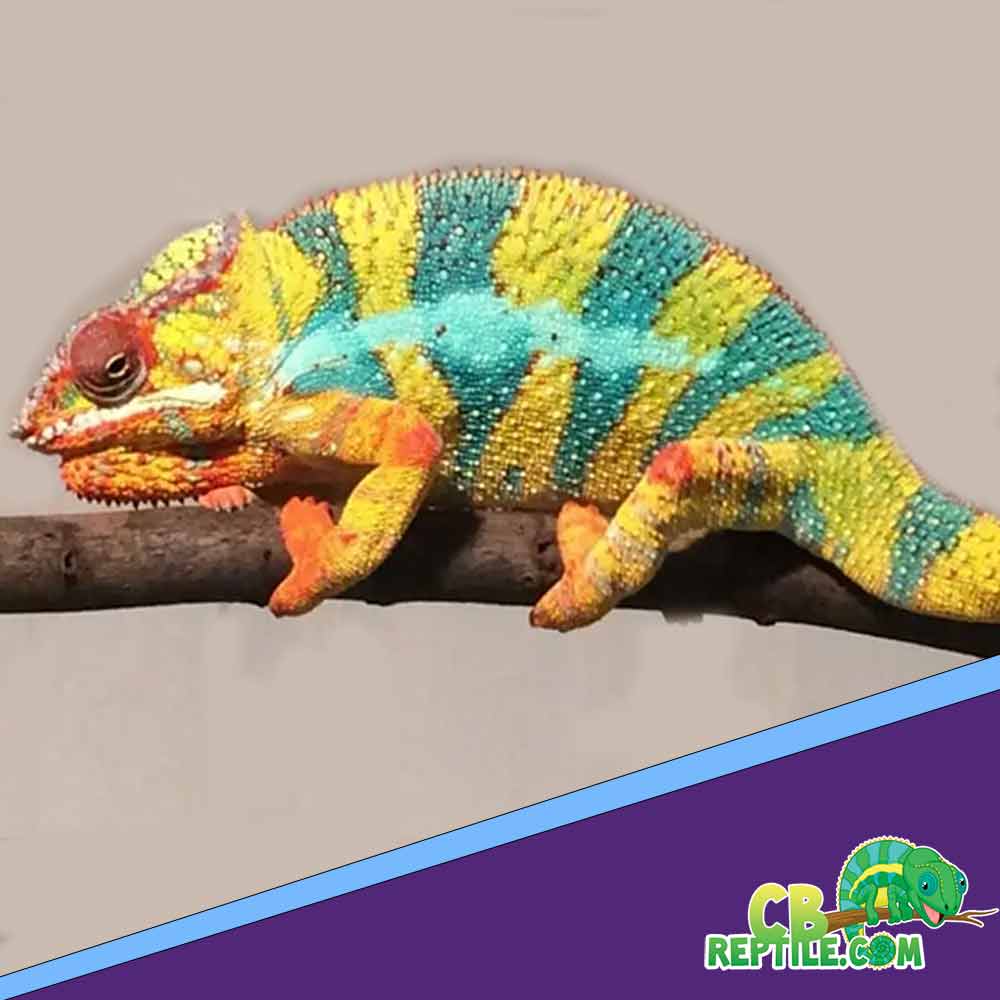
Age Requirements for Safe Pairing
Both chameleons must meet minimum age and size requirements to ensure safe reproduction. Pairing too early can lead to egg-binding, stunted growth, or extreme stress.
Male Requirements:
- Minimum age: 10–12 months
- Ideal age: 12–18 months
- Key indicator: Fully developed casque and strong color display
Female Requirements:
- Minimum age: 10 months
- Ideal age: 12+ months
- Key indicator: Proper body mass and no signs of premature cycling
Females should not be bred prematurely. An underdeveloped female is at risk of dystocia (egg binding), which can be fatal.

Pre-Pairing Conditioning
Before pairing, both chameleons should receive several weeks of optimal husbandry to ensure peak reproductive condition.
Conditioning includes:
- Increasing feeder variety (silkworms, hornworms, roaches, BSFL)
- Proper gut-loading with calcium-rich greens
- Supplementing with calcium and a multivitamin at correct intervals
- Ensuring stable temperatures and UVB exposure
- Hydrating well with proper misting cycles
Healthy chameleons breed more successfully and produce stronger, healthier clutches.
Visual Introduction: The Most Important Step
Panther chameleons should never be placed together suddenly. The introduction process must be gradual and controlled.
Phase 1 — Visual Contact Only
Place the female in full view of the male but in a separate enclosure. Observe behavioral cues carefully.
Positive female responses:
- Calm coloration (soft greens, blues, or yellows depending on locale)
- Remaining still or exploring non-defensively
- No gaping or hissing
Negative responses (DO NOT PAIR):
- Dark mottled coloration
- Hissing or lunging at the male
- Gaping or rocking behavior
If the female becomes defensive, she is likely not receptive and must not be paired.

Behavioral Cues of Receptive Females
A receptive female is key to safe and successful pairing. Behavioral signals include:
- Bright receptive coloration (greens, yellows, or soft blues)
- Calm posture without defensive behaviors
- Allowing the male to approach
- Remaining still or climbing slowly
Dark, banded, or spotted coloration is a sign of rejection or gravidity.
The Pairing Process Step-by-Step
Step 1 — Introduce the Female into the Male’s Territory
Males are typically less stressed in their own enclosure. Place the female inside the male’s enclosure and immediately observe their interaction.
Step 2 — The Male Begins Courtship
Courtship behaviors include:
- Brighter coloration
- Slow, deliberate rocking movement
- Approaching from the side
- Displaying the flank patterns
Step 3 — Copulation
If the female accepts the male, the process is typically calm and lasts several minutes to over an hour.
Step 4 — Immediate Separation
Once mating is complete, the female must be removed immediately. Leaving the pair together can result in aggression and injury.
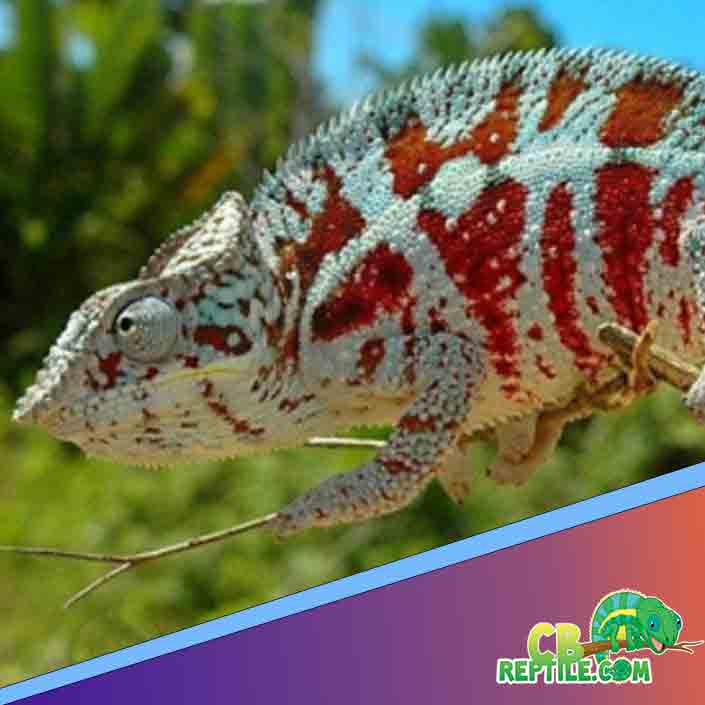
How to Know if Breeding Was Successful
Signs of successful copulation include:
- Female shifting into gravid coloration after separation
- Increased appetite for 1–2 weeks
- Rapid weight gain
- Exploratory digging behavior after 15–30 days
Females will need a properly prepared lay bin soon after mating.
Common Pairing Problems (and Solutions)
Problem 1 — The Male Shows No Interest
Causes may include:
- Male too young
- Improper temperatures or UVB
- Recent stress or shedding
Problem 2 — Female Rejects the Male
This occurs if she is already gravid or not receptive. Wait 1–2 weeks and try the visual check again.
Problem 3 — Aggression Occurs
Remove the female immediately. Injury risk is high if the pairing is not compatible.
Genetic Considerations When Pairing
Ethical breeding requires maintaining strong genetics, avoiding defects, and preserving locale purity unless producing labeled hybrids.
Best genetic practices:
- Pair same-locale males and females
- Avoid inbreeding by tracking lineage
- Document parental traits and coloration
- Keep detailed hatchling records
Strong genetics produce consistently healthy babies with true locale expression.
Choosing the Best Breeders for Your Program
Selecting high-quality breeders ensures strong coloration, predictable traits, and healthy offspring. When browsing a chameleon for sale, ensure that lineage, health history, and breeder reputation are fully disclosed. Responsible sourcing ensures you always know we are the best option for where to buy panther chameleon that will perform well in breeding programs.
Final Thoughts on Pairing Panther Chameleons
Successful pairing requires patience, observation, and respect for chameleon behavior. When done properly, the process is smooth, safe, and rewarding. By selecting healthy captive-bred adults, understanding receptive behaviors, conducting slow introductions, and carefully monitoring interactions, breeders can maintain ethical, responsible breeding programs that produce strong, beautiful offspring for generations.

